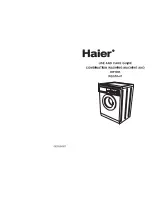
WARNING
The correct exhaust installation is YOUR RESPONSIBILITY.
•
Use a 4-inch (10.2cm) diameter rigid aluminum or rigid galvanized
steel duct.
•
Do not use smaller diameter than recommended diameter duct.
•
Ducts larger than 4 inches (10.2cm) in diameter can result in
increased accumulation of lint and changes in performance
•
Lint should be removed from internal filter before every cycle and
clean ducts periodicly.
•
If a flexible metal duct must be used, use the type with a stiff sheet
metal wall. Do not use a flexible duct with a thin foil wall. A serious
blockage can result if the flexible metal duct is bent too sharply.
•
Never install any type of flexible duct in walls, ceilings, or other
concealed spaces.
•
Keep the exhaust duct as straight, short as possible, minimum elbows
•
Secure joints with duct tape. Do not use screws.
•
Plastic flexible ducts can kink, sag, be punctured, reduce airflow,
extend drying times, and affect the dryer operation.
•
Exhaust systems longer than recommended 90 ft can extend drying
times, affect machine operations, and collect lint.
•
The exhaust duct should end with an exhaust hood with a swing-out
damper to prevent back drafts and entry of wildlife. Never use an
exhaust hood with a magnetic damper.
•
The hood should have at least 12 inches (30.5cm) of clearance
between the bottom of the hood and the ground or other
obstruction. The hood opening should point down.
•
Never install a screen over the exhaust outlet.
•
To avoid lint buildup, do not exhaust the dryer directly into a window
well. Do not exhaust under a house or porch.
•
If the exhaust duct must run through an unheated area, the duct
should be insulated and slope slightly down towards the exhaust
hood to reduce condensation and lint buildup.
•
Inspect and clean the interior of the exhaust system at least once a
year. Unplug the power cord before cleaning.
•
Check frequently to make sure the exhaust hood damper opens and
closes freely.
•
Check once per month, and clean at least once per year. NOTE:
If your clothes are not getting dry, then check the ducting for
obstructions.
•
Do not exhaust the dryer into a wall, ceiling, crawl space, or
concealed space of a building, gas vent, or any other common duct
or chimney. This could create a fire hazard from the lint expelled by
the dryer.
•
Do not use non-metallic flexible duct.
•
To reduce the risk of fire, this dryer MUST BE EXHAUSTED
OUTDOORS without obstruction around the outlet.
Dry
er
Saf
ety
Oper
ation
R
equir
ements
P
arts and
F
eatur
es
Ins
tallation
Ins
tructions
Dry
er Use
A
p
p
e
nd
ix
Dry
er Car
e
T
ro
u
b
le
sh
o
o
tin
g
13
Содержание MLE45N1BWW
Страница 1: ...MLE45N1BWW MLG45N1BWW MLE45N3BWW MLG45N3BWW 1 844 224 1614...
Страница 50: ......
Страница 51: ...MLE45N1BWW MLG45N1BWW MLE45N3BWW MLG45N3BWW...
Страница 100: ......
Страница 101: ......
Страница 102: ...1 844 224 1614...














































